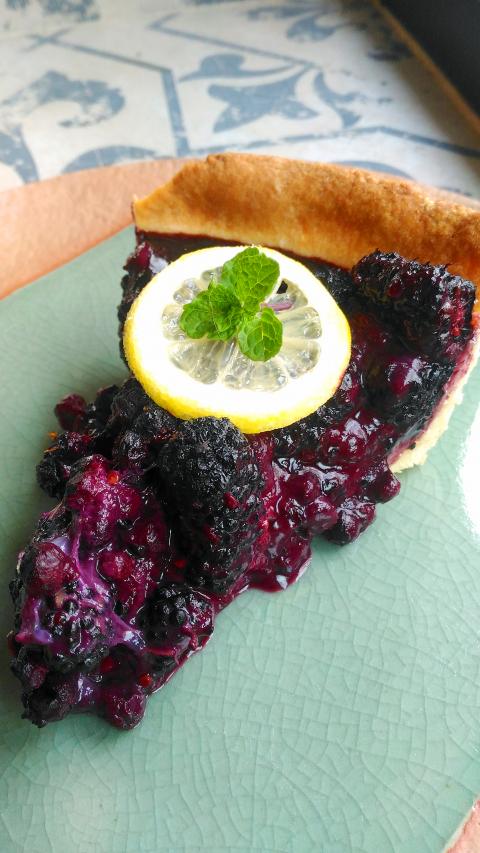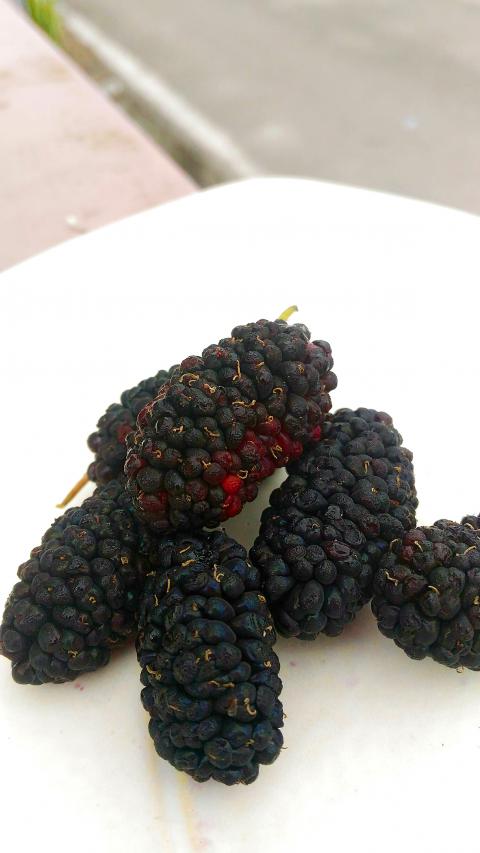Fresh berries are no longer unusual in Taiwan, though almost all are imported, slightly diminishing their appeal. Local strawberries have gradually established a strong presence, but raspberries, blackberries and blueberries all come from abroad, and though quality is generally good, prices are high.
Mulberries, on the other hand, are native to Taiwan and while the fruit of this berry has never quite attained the same culinary status, the attraction of a local berry that thrives in Taiwan’s humid climate and which provides abundant fruit is enormously appealing, not least as the plant’s robustness means that the fruit is less likely to be tainted with pesticide residue.
Mulberries can be either purple or white, the latter primarily cultivated as part of the silk industry and its fruit is not highly regarded, though there is no shortage of information on the Internet claiming significant health benefits from its consumption. Anyway, for the moment, we will focus on the black or purple mulberry (Morus nigra), which has a long history of being cultivated for food.

Photo: Ian Bartholomew
In Taiwan, mulberries are primarily used in the making of jam, an indication of their relative profusion and low cost. It would be nice to say that mulberry jam is a match for other breakfast perennials such as strawberry or raspberry jam, but this, in my opinion abouat least, is far from being the case. A strong desire to use local products has not succeeded in ousting the Tiptree jams from my pantry.
Part of the problem seems to be that the flavor of mulberries lack complexity, and that they are much better eaten simply as fruit. In fact, my favorite way of consuming mulberries is simply to toss them in a little icing sugar, just to balance out the tartness, but otherwise letting its flavor alone. Even the addition of whipped cream, which is such a potent boost to fruit dishes, does not seem to be desirable in this case.
Making a jam is pretty simple, requiring no more than a three-to-one ratio of fruit to sugar, some lemon juice and some gelatin to firm things up at the end. I have a slight horror of gelatin and often use cooked down apple, with core and seeds, to extract the natural pectin, and this works pretty well. To make a cordial, simply strain out the solids, and this syrup can be kept in the fridge and mixed with cold water, or sparkling water if you have it on hand, for a refreshing drink.

Photo: Ian Bartholomew
These are popular ways to access the significant health benefits of mulberries, which include iron, riboflavin, vitamin C, vitamin K, potassium, phosphorus and calcium, as well as a wide range of organic compounds such as anthocyanins, which are regarded as having almost miraculous antioxidant powers. That said, some nutritionists warn that cooking the mulberries in any way diminishes their powers, as heat destroys compounds such as anthocyanins. But while eating fresh mulberries straight out of the punnet is fine, you sometimes want to put a bit of variety into your diet, and surely some small nutritional sacrifices can be made to that end. When selecting black mulberries, make sure to avoid pale fruit, which is unripe and should not be eaten. The fruit gradually deepens in color, from a pale ivory, then turning pink, then purple verging on black. The fruit should be a uniform dark color, but firm. Wash and drain before eating. Some people recommend removing the short stem from the fruit, but this can be a messy process and the stem can be retained if you don’t mind eating them or intend to strain out solids, as with the making of a cordial.
Mulberry tart
Recipe (serves 8)
Tarts and pies can be intimidating, especially in Taiwan where quality commercial pie crusts are not readily available and for the most part home cooks are faced with making everything from scratch, whether they want to or not. This often means doing something else, and I have often been sent in the direction of crumbles and cobblers simply because the prospect of, not so much making the pastry, but of all the chilling and blind baking before getting the pie in the oven. For this quick fix for putting fresh berries in a pastry case, I have used a traditional pate sucree, a sweet short crust, cribbed from an old Michel Roux (father not son) cookbook. It is not the best pastry case in the world, but makes up for its flaws by its relative ease of preparation, which is in keeping with the rather off-hand manner to adding fruit with a minimum of preparation.
For the pastry:
250g all-purpose flour
100g butter, diced
100g icing sugar
a pinch of salt
2 eggs, lightly beaten
For the filling:
500g fresh mulberries
300g fresh or frozen blueberries
1/4 cup granulated sugar
zest of 1 lemon
1 tbsp flour
1 egg, lightly beaten
Directions:
1. Sift the flour into a bowl and make a well in the center.
2. Placed the diced butter in the center and knead with the fingers until soft, pulling in a little flour.
3. Add the icing sugar, lemon zest and pinch of salt. Continue to knead with fingers or a stiff spatula, pulling in the rest of the flour.
4. Add the egg and mix until the dough comes together.
5. Roll into a ball then press down with the heel of your hand to make a disc. Wrap in cling film and put in the fridge for at least one hour or overnight.
6. Grease a deep 28cm pie dish with butter. Roll out the pastry and lay it in the dish. Allow some overflow as the pastry will contract slightly when cooking.
7. Place the crust in a pre-heated over at 180c for 15 minutes. Remove and allow to cool while you put the fruit together.
8. Put all the ingredients for the filling in a bowl and mix well.
9. Pour it into the crust and place in the oven at 180c for 40 minutes.
10. Allow to cool before cutting.
Ian Bartholomew runs Ian’s Table, a small guesthouse in Hualien. He has lived in Taiwan for many years writing about the food scene and has decided that until you look at farming, you know nothing about the food you eat. He can be contacted at Hualien202@gmail.com.

Behind a car repair business on a nondescript Thai street are the cherished pets of a rising TikTok animal influencer: two lions and a 200-kilogram lion-tiger hybrid called “Big George.” Lion ownership is legal in Thailand, and Tharnuwarht Plengkemratch is an enthusiastic advocate, posting updates on his feline companions to nearly three million followers. “They’re playful and affectionate, just like dogs or cats,” he said from inside their cage complex at his home in the northern city of Chiang Mai. Thailand’s captive lion population has exploded in recent years, with nearly 500 registered in zoos, breeding farms, petting cafes and homes. Experts warn the

The unexpected collapse of the recall campaigns is being viewed through many lenses, most of them skewed and self-absorbed. The international media unsurprisingly focuses on what they perceive as the message that Taiwanese voters were sending in the failure of the mass recall, especially to China, the US and to friendly Western nations. This made some sense prior to early last month. One of the main arguments used by recall campaigners for recalling Chinese Nationalist Party (KMT) lawmakers was that they were too pro-China, and by extension not to be trusted with defending the nation. Also by extension, that argument could be

Aug. 4 to Aug. 10 When Coca-Cola finally pushed its way into Taiwan’s market in 1968, it allegedly vowed to wipe out its major domestic rival Hey Song within five years. But Hey Song, which began as a manual operation in a family cow shed in 1925, had proven its resilience, surviving numerous setbacks — including the loss of autonomy and nearly all its assets due to the Japanese colonial government’s wartime economic policy. By the 1960s, Hey Song had risen to the top of Taiwan’s beverage industry. This success was driven not only by president Chang Wen-chi’s

Last week, on the heels of the recall election that turned out so badly for Taiwan, came the news that US President Donald Trump had blocked the transit of President William Lai (賴清德) through the US on his way to Latin America. A few days later the international media reported that in June a scheduled visit by Minister of National Defense Wellington Koo (顧立雄) for high level meetings was canceled by the US after China’s President Xi Jinping (習近平) asked Trump to curb US engagement with Taiwan during a June phone call. The cancellation of Lai’s transit was a gaudy